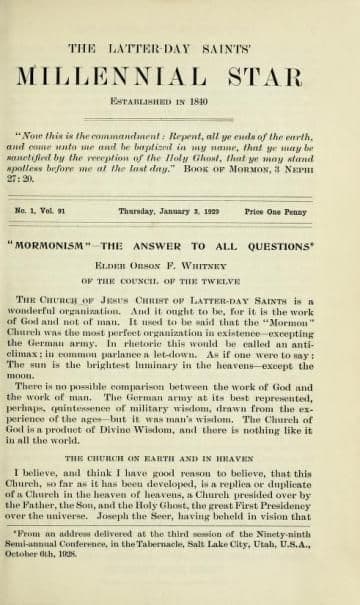Magazine
Book of Mormon Studies (3 January 1929)

Title
Book of Mormon Studies (3 January 1929)
Magazine
The Latter Day Saints' Millennial Star
Publication Type
Magazine Article
Year of Publication
1929
Authors
Widtsoe, John A. (Primary)
Number of Pages
14
Date Published
3 January 1929
Volume
91
Issue Number
1
Abstract
BOOK OF MORMON STUDIES1
With this lesson we conclude the book of Alma, the largest subdivision in the Book of Mormon. Chapters 59 to 63, inclusive, are to be studied. Aside from historical narratives, aside from sound wisdom and doctrinal value, by which the book of Alma particularly is characterized, one of the striking lessons to be gained from these chapters eoncerns the case with which misunderstandings can oceur among men and women when all the facts in the case are not known.
Moroni was in need of assistance. He sought it by letter at the hands of the ehief judge, Pahoran, but received no satisfactory reply. Under pressure of trying conditions he rebuked Palioran by letter in anger. When all the facts were known to Moroni, however, he learned that he had misjudged—Pahoran had need of assistance himself. The bigness of Moroni is shown in the acknowledgment of his error and his immediate steps to do all in his power to assist Pahoran.
Those Book of Mormon characters were human, just as we are human. Perhaps we can take a lesson from their experience—to judge not when we have only slight knowledge of the facts—or better, to judge not at all.
QUESTIONS
- To what cause did Moroni attribute the temporary losses of the Nephites? See Alma 59:11-13. In your estimation was he correct in his analysis?
- Even in his greatness, Moroni was human—he thought that his troubles were greater than others’. What lesson may we derive from this?
- Discuss Alma 61:21. This applies to all men, everywhere. How does it hold true in our missionary work? In our homes? In our daily labours?
- Pahoran’s reply shows the chief peril of the Nephite nation to be from within and not from without. Discuss this as a fundamental principle applied to any nation. To institutions generally. To individuals.
- Neither dissenters within nor enemies without could withstand the righteous among the Nephites when they were united. Has this applied in our Church? Does it apply to-day? Does it apply to our home and society in general? How?
- Two men in turn—Amalickiah and Ammoron—were directly responsible for the wars of this period. Using this instance as an example discuss the responsibility and power of leadership.
- 1. Lesson 1 of the Relief Society Course of Study—for use on the first lesson night in January.
Subject Keywords
Bibliographic Citation
Terms of use
Items in the BMC Archive are made publicly available for non-commercial, private use. Inclusion within the BMC Archive does not imply endorsement. Items do not represent the official views of The Church of Jesus Christ of Latter-day Saints or of Book of Mormon Central.